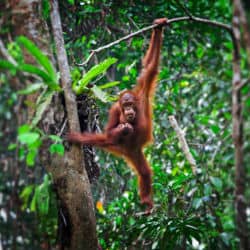Orangutan’s Hold The Key To How Human Speech Evolved

The latest research conducted by Indianapolis Zoo and the University of St Andrews suggests that great apes have the ability to control their voices in much the same way humans can providing a unique insight into how human language evolved. The researchers studied an 11-year old orangutan named Rocky and a 36-year old named Kobi. They analysed how the species uses its voice to play a musical instrument. In order speak, there is a requirement to be able to have control over vocal fold oscillation.
Speech traditionally considered unique to humans
Speech is traditionally associated with humans and considered unique to us. However, there is a growing body of data from across different disciplines that serves as evidence that great apes have the ability to control their voices. The researchers constructed a diagnostic test using a membranophone which is similar to a kazoo where voice is used to flare through oscillating air pressure. The instrument was used because it can only be activated by voice.
No training or conditioning
The researchers gave the instrument to the two orangutans in order to learn whether our nearest great ape relatives have the ability to control their voices and prod sounds they otherwise would not be able to generate. This ability is what enables humans to learn vowels of their native languages and the new voiced tones of second languages. The orangutans were able to activate the instrument within a few minutes of first coming to contact with it, ruling out training or conditioning.
Vocal fold action
The research demonstrates that vocalisation in orangutans is in fact the product of vocal fold action and the species has the ability to adjust voice frequency and duration both rapidly and meaningfully. This implies that the voice control displayed by great apes is different in the degree to which is demonstrated and not kind. The researchers say that language is the basis for all communication between humans but no scientific explanation exists for how it evolved.
First positive test
With great apes being the closest relatives to humans, the family of species may hold the key to how language evolved amongst humans. The results of the study are the first positive diagnostic test results for the ability to learn how to produce vocals in great apes. The study redefines how we understand how spoken language may have evolved. The results of the study compel humans to have a stronger attitude towards conservation at a time when great ape populations are under serious threat and their survival is in doubt.



